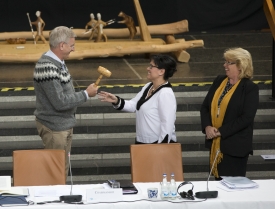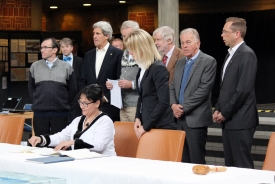The Eighth Ministerial Meeting of the Arctic Council was held 15 May 2013 in Kiruna, Sweden. Ministerial meetings are held every two years, marking the culmination of the Council's work under the current Chair and transition to new leadership. At the 2013 meeting the chair passed from Sweden to Canada, which will lead the Council through May 2015.

The Arctic Council is comprised of eight Member States (the arctic nations), six Permanent Participants (Indigenous peoples' organizations such as the Inuit Circumpolar Council), and many Observers (non-arctic countries, intergovernmental/inter-parliamentary organizations, and NGOs). At the Kiruna meeting, the Arctic Council reviewed several applications and granted Observer status to China, India, Italy, Japan, Singapore, and South Korea. The diverse group of nations holding Observer status with the Arctic Council is reflective of widespread political and economic interest in the arctic region.
Proceedings during the Ministerial Meeting included signing the Agreement on Cooperation on Marine Oil Pollution Preparedness and Response in the Arctic, a legally binding document. The Agreement is designed to improve procedures for combatting oil spills in the Arctic. This is the second legally binding agreement in the Arctic Council's history, preceded by the 2011 Agreement on Cooperation on Aeronautical and Maritime Search and Rescue in the Arctic.

Ministers also signed the Kiruna Declaration, which sets out the work of the Council during the 2013-2015 Canadian Chairmanship. The theme of Canada's chairmanship is "development for people of the North." They have specified three priorities for their two-year term as Chair: responsible arctic resource development, safe arctic shipping, and sustainable circumpolar communities.
Arctic Council Leadership
1998 Inauguration, Canada
1998-2000, United States of America
2000-2002, Finland
2002-2004, Iceland
2004-2006, Russian Federation
2006-2009, Norway
2009-2011, Denmark
2011-2013, Sweden
2013-2015, Canada
2015-2017, United States of America
Three reports were presented during the Eighth Ministerial Meeting:
- The Arctic Biodiversity Assessment produced by the Arctic Council's Conservation of Arctic Flora and Fauna working group presents the status and trends in arctic biodiversity and includes a synthesis, a report specifically for policymakers, and the full-length report.
- The Arctic Ocean Acidification Assessment produced by the Arctic Council's Arctic Monitoring and Assessment Programme (AMAP) looks at the potential impacts of acidification of the Arctic Ocean; the report includes a summary for policymakers and a key findings document, both available under the 'Publications online' link at the AMAP website.
- The Arctic Resilience Interim Report 2013, led by the Stockholm Environment Institute and the Stockholm Resilience Centre at Stockholm University, considers how changes in climate, ecosystems, economics, and society interact. . In addition to the full report, a summary for policymakers is available.
An Arctic Council press release regarding the Kiruna meeting is available here.
For further information about the Arctic Council, please see their website.
